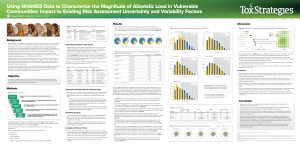Addressing the combined role of chemical and non-chemical stressors within cumulative impact assessments is a current focus of Environmental-Justice-related research at the U.S. Environmental Protection Agency. There is strong evidence that elevated socioeconomic and psychological stressors that may exist in a community have the potential to increase susceptibility to environmental exposures and exacerbate related health impacts. Characterization of these stress levels and their health impacts using biomarkers is an emerging field in assessing risk.
At the recent 2023 annual meeting of the Society of Toxicology, held in Nashville, Tennessee, ToxStrategies presented a method for quantifying accumulated stress (allostatic load) in a subpopulation that would be identified by the EPA EJScreen tool as disproportionately susceptible. The method also can allow comparison of this subpopulation’s stress to that of the general U.S. population.
Starting with the EJScreen tool and using National Health and Nutritional Examination Survey (NHANES) data, subpopulations defined by certain non-chemical stressors were identified and evaluated for allostatic load. ToxStrategies’ poster (click here) provides a roadmap for evaluating and quantifying allostatic load in a cumulative impact assessment. This work provides a starting point for linking non-chemical stressors to health impacts in communities that bear disproportionate levels of stress.
ToxStrategies is focused on developing and applying the best science for cumulative impact assessments that support evidence-based interventions for reducing disproportionate impacts. More information on ToxStrategies’ services related to cumulative impact assessment and environmental justice can be found here, or call us at (614) 204-6467.

